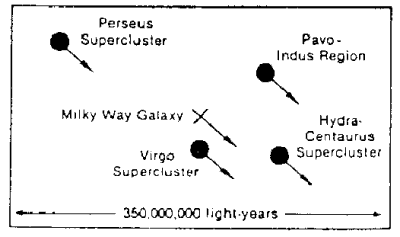 |
Science Frontiers ONLINE No. 47: Sep-Oct 1986 |
|
|
Lumps, clumps, and jumps
"Astronomers have already discovered lumps, motion and structure never suspected in a universe once considered smooth and expanding uniformly in all directions. Two researchers now say the universe is even lumpier, has faster relative motion and shows larger structures than previously believed."
N. Bahcall and R. Soneira have been studying the structures and motions of superclusters of galaxies. Each supercluster consists of clusters of clusters of galaxies and contains upwards of hundreds of billions of stars. (Obvious-ly, these are not inconsequential entities!) By analyzing the redshifts of galaxies, Bahcall and Soneira have found that the universe is much more dynamic and inhomogeneous than expected.
(1) The clusters of galaxies are larger and more extensive. Superclusters can be 500 million light years across -- about 1% of the known universe
(2) Relative motions within the clusters are as high as 2,000 kilometers per second more than one can account for using gravitational attraction alone.
(Kleist; T.; "Lumps, Clumps and Jumps in the Universe," Science News, 130:7, 1986.)
Comment. Before swallowing whole such grand sketches of the cosmos, one should always examine the assumptions. Here, redshifts are assumed to be measures of velocity, which if an expanding universe is assumed, can be converted into distances.
 | Local Group of galaxies, including the Milky Way. and nearby superclusters are all moving in the same direction at about the same speeds. (Adapted from Sky and Telepscope, 72:28, 1986) |